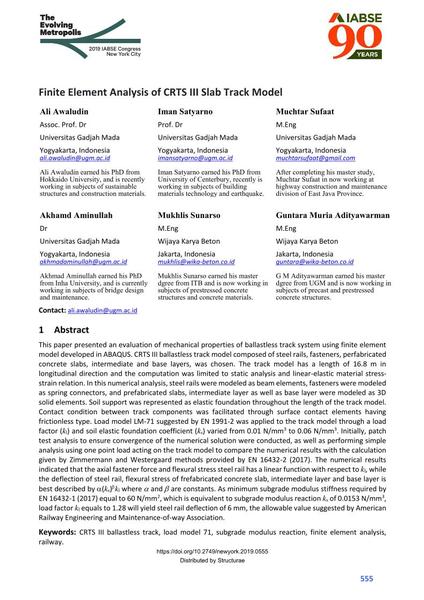Finite Element Analysis of CRTS III Slab Track Model

|
|
|||||||||||
Bibliographic Details
| Author(s): |
Ali Awaludin
(Universitas Gadjah Mada)
Iman Satyarno (Universitas Gadjah Mada) Muchtar Sufaat (Universitas Gadjah Mada) |
||||
|---|---|---|---|---|---|
| Medium: | conference paper | ||||
| Language(s): | English | ||||
| Conference: | IABSE Congress: The Evolving Metropolis, New York, NY, USA, 4-6 September 2019 | ||||
| Published in: | The Evolving Metropolis | ||||
|
|||||
| Page(s): | 555-564 | ||||
| Total no. of pages: | 10 | ||||
| DOI: | 10.2749/newyork.2019.0555 | ||||
| Abstract: |
This paper presented an evaluation of mechanical properties of ballastless track system using finite element model developed in ABAQUS. CRTS III ballastless track model composed of steel rails, fasteners, perfabricated concrete slabs, intermediate and base layers, was chosen. The track model has a length of 16.8 m in longitudinal direction and the computation was limited to static analysis and linear-elastic material stress- strain relation. In this numerical analysis, steel rails were modeled as beam elements, fasteners were modeled as spring connectors, and prefabricated slabs, intermediate layer as well as base layer were modeled as 3D solid elements. Soil support was represented as elastic foundation throughout the length of the track model. Contact condition between track components was facilitated through surface contact elements having frictionless type. Load model LM-71 suggested by EN 1991-2 was applied to the track model through a load factor (k1) and soil elastic foundation coefficient (ks) varied from 0.01 N/mm³ to 0.06 N/mm³. Initially, patch test analysis to ensure convergence of the numerical solution were conducted, as well as performing simple analysis using one point load acting on the track model to compare the numerical results with the calculation given by Zimmermann and Westergaard methods provided by EN 16432-2 (2017). The numerical results indicated that the axial fastener force and flexural stress steel rail has a linear function with respect to kl, while the deflection of steel rail, flexural stress of frefabricated concrete slab, intermediate layer and base layer is best described by α(ks)βk1where α and β are constants. As minimum subgrade modulus stiffness required by EN 16432-1 (2017) equal to 60 N/mm², which is equivalent to subgrade modulus reaction ksof 0.0153 N/mm³, load factor k1equals to 1.28 will yield steel rail deflection of 6 mm, the allowable value suggested by American Railway Engineering and Maintenance-of-way Association. |
||||
| Keywords: |
finite element analysis FEA railroad CRTS III ballastless track load model 71 subgrade modulus reaction
|
||||
